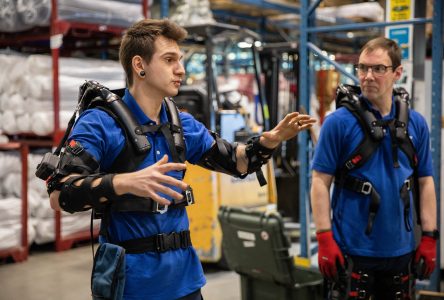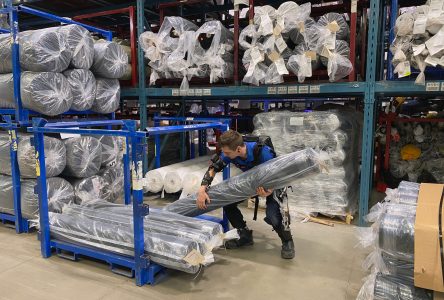By Stephanie MacFarlane
An innovative pilot project has been running at Logistik Unicorp for several months. Warehouse workers work with exoskeletons developed by Mawashi Sciences et Technologies, another company from Saint-Jean-sur-Richelieu. This equipment aims to improve workers’ physical performance and endurance and help them handle loads safely.
Founded in its early days at Logistik Unicorp, the technology company Mawashi developed the exoskeleton UPRISE for the military sector. Inspired by sumo wrestlers, this gear allows soldiers to carry a load of 50% to 80% of their own weight without restricting their mobility. How? By distributing the mass of the gear worn across the body.
For several years, Mawashi, now based at Pierre Caisse Street, has been working to bring this innovation to the civilian sector with the development of the UPLIFT exoskeleton. objective? Reduce worker fatigue and risk of MSDs.

pilot project
Last summer, seven Mawashi exoskeletons arrived at Logistik Unicorp as part of a pilot project. They are used for handling activities. The employees take orders in the fabric department, which is housed in the 20,000 square meter warehouse. You have to take the rolls of fabric from the pallets and put them in the right places. The weight of a roll varies from 20 to 110 pounds. Usually they have to handle them in pairs.
“With the exoskeleton, they can handle most tissues on their own,” says Nicolas Robert, Chief Operating Officer at Logistik Unicorp. Above all, however, handling is even safer. “The exoskeleton enables the joints and muscles to be relieved. It reduces pain, back pressure and fatigue,” summarizes Mr. Robert.
Three mods
The exoskeleton consists of three modules: one for the back, one for the arms and one for the legs. Various combinations are possible, but the backpack is required to use the other two.
The units are available in different sizes and are adjustable, which allows them to be adapted to different body sizes. Depending on the modules chosen, it costs between $4,000 and $12,000 per exoskeleton. The full version, consisting of all three units, costs $12,000.
According to Mawashi, the UPLIFT exoskeleton can increase users’ endurance by 40%. Depending on the movement and muscle, the device can reduce muscle activation by 20% to 70%. This allows the worker to exert less effort to complete a task.
The exoskeleton, which can be put on in a few simple steps, is equipped with an activation device. When activated, the device reduces muscle use during load handling. Another benefit: it comes to support the movements of the user. In other words, the exoskeleton forces him to push hard by preventing him from making a wrong move.

When the device is disabled, the worker can move at will. He can occupy himself with other tasks, for example driving a forklift.
evolution
The exoskeleton uses passive technology, meaning it is not powered by a battery or electronics. The pilot carried out at Logistik Unicorp allows Mawashi to improve its product to make it more functional.
A second version was developed based on employee feedback. To increase comfort, pressure points on the body have been eliminated and exoskeleton settings have been improved.
Changes have also been made to the shoulders to increase mobility and allow for a greater range of motion. The new version is also lighter. New materials were used for some components.
health and safety
Logistik Unicorp is testing the exoskeleton in its various departments to see where this tool is useful. “160 workers work in the warehouse. We have to see in which role the exoskeleton works,” continues Nicolas Robert.
Previously, it was helpful for employees who perform heavy and repetitive tasks. The exoskeleton can also benefit workers who handle small loads, but in a repetitive manner. “The exoskeleton helps the worker perform safe movements and limits lumbar spine rotation,” says Robert. The pilot project is scheduled to run until next summer.
Logistics Unicorp emphasizes that it uses a scientific approach to preventively improve the health and safety of its employees. “It’s about the long-term quality of life of our employees. This tool makes it possible to reduce the effort and to protect the physical integrity of the employees,” continues Nicolas Robert.
innovation
The exoskeleton is not the first innovation to premiere at Logistik Unicorp. The Chemin du Grand-Bernier Nord company works with artificial intelligence. This technology has made it possible to limit the number of daily steps taken by workers by analyzing the layout of items in the warehouse. “With artificial intelligence, we can create the ideal route,” explains Nicolas Robert.
Another project involves artificial intelligence to increase the number of complete orders sent to customers to reduce greenhouse gases, reduce the potential for errors and improve customer satisfaction. In addition, robots have been supporting employees in the warehouse since 2019.

Extreme problem solver. Professional web practitioner. Devoted pop culture enthusiast. Evil tv fan.




;Composite=(type=URL,url=https://images.radio-canada.ca/v1/assets/elements/16x9/outdated-content-2021.png),gravity=SouthEast,placement=Over,location=(0,0),scale=1)


